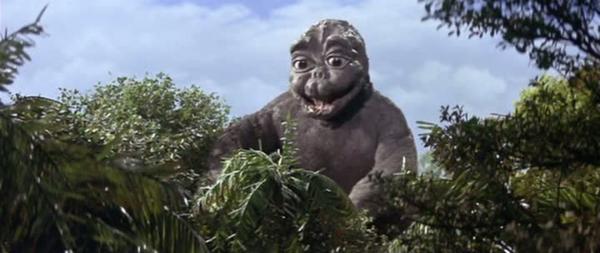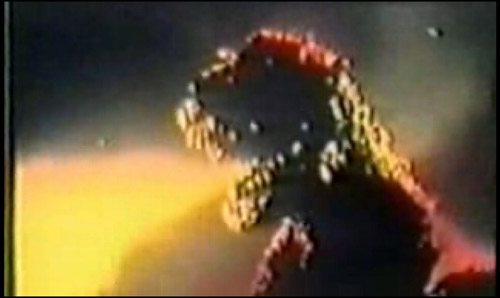Son of Godzilla
aka Monster Island’s Decisive Battle: Godzilla’s Son aka Kaiju-shima no Kessen Gojira no Musuko

1967![]()

Directed by Jun Fukuda
 |
|
Hey, what the hell are you doing in my shower??
|
Son of Godzilla is a damn awesome film, but it is also a film that you pretty much need to see as a kid. Looking back on the film as an adult, there are plenty of things wrong, but there are plenty of things right. And as the waves of nostalgia wash over you, even the few problems you see melt away into the bliss of Minya. I can imagine people viewing this for the first times as adults, and much of the magic will be gone.
I still have the VHS tape of Son of Godzilla I bought with my own money as a small kid. I didn’t want to wait for the film to pop up on TBS’s Super Scary Saturday or the local station KLJB-TV which would sometimes show Godzilla movies during their Sunday “we gotta air SOMETHING!” programming. I watched that tape like crazy, it getting just as much play as Godzilla’s Revenge, Ghidrah, and a few other Godzilla flicks I watched religiously.
 |
|
That’s right, baby. Not ten minutes old and chicks are lining up to serve me!
|
Minya was designed to appeal to kids, and it worked beautifully. He’s the ultimate lure to get kids even more excited to watch the monster films. It’s the same old gimmick as masked crimefighters having young kid sidekicks. Minya isn’t even the first monster kid, Kong had a son decades before Godzilla was even a reality. But Minya has stood the test of time and even survived a brief attempt to usurp him of his role as Godzilla’s son. Suck it, Godzilla Junior, you’re just a second rate extra from Dinosaurs!
Son of Godzilla features two other new monsters, Kumonga and Kamacuras, aka Speiga and Gimantis. Both are creepy bug monsters, preventing anyone becoming attached to them instead of Minya or Godzilla as the heroes. Sure, there are people who are into spiders and insects, and even Mothra is a hero, but the gut reaction of the bugs vs. the cute kid is obviously what they were going for.
 |
|
Wheeeeeeeeeeeeeeeeeeeeeeeee!!!!!!!!!!
|
Just FYI, I’m calling them Minya, Speiga, and Gimantis through the plot section. None of that Minilla, Kumonga, or Kamacuras crap. That’s because these are the names I grew up with. And this is my review, so I can do what I want! Nyeh nyeh nyeh!
The remote island location with the small science crew allows for some lower budget action. They realize they need a character to have everything explained to, so in airdrops the standard reporter character. Godzilla films need reporter and scientist characters, it is the peanut butter and chocolate on the kaiju bread. Despite many of the characters getting no lines and just wandering around in the background, some of them are pretty heavy hitters.
 |
|
LLLLLLLLLLLLLLLLLLLLLLadies!
|
So I did my best with the cast list, several of the researchers don’t really get names or personalities, so I played mix and match.

|
Kaiju Roll Call!
|
 |
|
I’m totally gonna Serve you, Gimantis! I see some haters grillin’ I see some ladies chillin’ I see that girlie I’ve been plottin’ to get She can hop in the whip And we can Pump p p Pump Pump it up
|















